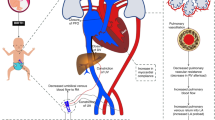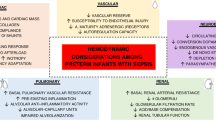Abstract
The complexity of postnatal cardiovascular transition has only recently been better appreciated in the very low birth weight neonate. As blood pressure in itself poorly represents systemic blood flow, especially when the fetal channels are open and the developmentally regulated vital organ assignment may not have been completed, efforts to measure systemic blood flow have resulted in a novel, yet incomplete, understanding of the principles and clinical relevance of cardiovascular adaptation during postnatal transition in this patient population. This article describes the definition of hypotension based on the principles of cardiovascular physiology, and reviews the tools available to the clinician and researcher at the bedside to examine the complex relationship among blood pressure, systemic and organ blood flow, and tissue oxygen delivery and oxygen demand in vital and non-vital organs in the very low birth weight neonate. Only after gaining an insight into these complex relationships and processes will we be able to design clinical trials of selected treatment modalities targeting relevant patient sub-populations for the management of neonatal cardiovascular compromise. Only clinical trials based on a solid understanding of developmental cardiovascular physiology tailored to the appropriate patient sub-population hold the promise of being effective and practical, and can lead to improvements in both hemodynamic parameters and clinically relevant outcome measures.
This is a preview of subscription content, access via your institution
Access options
Subscribe to this journal
Receive 12 print issues and online access
$259.00 per year
only $21.58 per issue
Buy this article
- Purchase on Springer Link
- Instant access to full article PDF
Prices may be subject to local taxes which are calculated during checkout



Similar content being viewed by others
References
Engle WD . Definition of normal blood pressure range: the elusive target. In: Kleinman CS and Seri I (eds). Neonatology Questions and Controversies: Hemodynamics and Cardiology. Saunders/Elsevier Co: Philadelphia, 2008, pp 39–66.
Kluckow M, Seri I . Clinical presentations of neonatal shock: the VLBW infant during the first postnatal day. In: Charles Kleinman and Istvan Seri (eds). Neonatology Questions and Controversies: Hemodynamics and Cardiology. Saunders/Elsevier Co: Philadelphia, 2008, pp 147–177.
Emery EF, Greenough A, Gamsu HR . Randomized controlled trial of colloid infusions in hypotensive preterm infants. Arch Dis Child 1992; 67: 1185–1188.
Roze JC, Tohier C, Maingueneau C, Lefevre M, Mouzard A . Response to dobutamine and dopamine in the hypotensive very preterm infant. Arch Dis Child 1993; 69: 59–63.
Seri I, Rudas G, Bors Z, Kanyicska B, Tulassay T . Effects of low-dose dopamine infusion on cardiovascular and renal functions, cerebral blood flow, and plasma catecholamine levels in sick preterm neonates. Pediatr Res 1993; 34: 742–749.
Seri I, Abbasi S, Wood DC, Gerdes JS . Regional hemodynamic effects of dopamine in the sick preterm infant. J Pediatr 1998; 133: 728–734.
Lundstrom K, Pryds O, Greisen G . The hemodynamic effects of dopamine and volume expansion in sick preterm infants. Early Hum Dev 2000; 57: 157–163.
Osborn D, Evans N, Kluckow M . Randomized trial of dobutamine versus dopamine in preterm infants with low systemic blood flow. J Pediatr 2002; 140: 183–191.
Noori S, Friedlich P, Wong P, Ebrahimi M, Siassi B, Seri I . Hemodynamic changes following low-dose hydrocortisone administration in vasopressor-treated neonates. Pediatrics 2006; 118: 1456–1466.
Noori S, Friedlich P, Seri I . Cardiovascular effects of sildenafil in neonates and infants with congenital diaphragmatic hernia. Neonatology 2007; 91: 92–100.
McLean CW, Cayabyab R, Noori S, Seri I . Cerebral circulation and hypotension in the premature infant- diagnosis and treatment. In: Perlman JM (ed). Neonatology Questions and Controversies: Neurology. Saunders/Elsevier Co: Philadelphia, 2008, pp 3–26.
Perlman JM, McMenamin JB, Volpe JJ . Fluctuating cerebral blood flow velocity in respiratory distress syndrome: relation to the development of intraventricular hemorrhage. N Engl J Med 1983; 309: 204–209.
Van Bel F, Van de Bor M, Stijnen T, Baan J, Ruys JH . Aetiological role of cerebral blood flow alterations in development and extension of peri-intraventricular hemorrhage. Dev Med Child Neurol 1987; 29: 601–614.
Miall-Allen VM, de Vries LS, Whitelaw AG . Mean arterial pressure and neonatal cerebral lesions. Arch Dis Child 1987; 62: 1068–1069.
Bada HS, Korones SB, Perry EH, Arheart KL, Ray JD, Pourcyrous M et al. Mean arterial blood pressure changes in premature infants and those at risk for intraventricular hemorrhage. J Pediatr 1990; 117: 607–614.
Tsuji M, Saul PJ, duPlessis A, Eichenwald E, Sobh J, Crocker R et al. Cerebral intravascular oxygenation correlates with mean arterial pressure in critically ill premature infants. Pediatrics 2000; 106: 625.
Hunt R, Evans N, Rieger I, Kluckow M . Low superior vena cava flow and neurodevelopment at 3 years in very preterm infants. J Pediatr 2004; 145: 588–592.
Goldstein RF, Thompson Jr RJ, Oehler JM, Brazy JE . Influence of acidosis, hypoxemia, and hypotension on neurodevelopmental outcome in very low birth weight infants. Pediatrics 1995; 95: 238–243.
Dammann O, Allred EN, Kuban KC, Van Marter LJ, Pagano M, Sanocka U et al. Systemic hypotension and white matter damage in preterm infants. Dev Med Child Neurol 2002; 44: 82–90.
Seri I . Circulatory support of the sick newborn infant. Semin Neonatol 2001; 85–95.
Greisen G . Autoregulation of cerebral blood flow in newborn babies. Early Hum Dev 2005; 81: 423–428.
Munro MJ, Walker AM, Barfield CP . Hypotensive extremely low birth weight infants have reduced cerebral blood flow. Pediatrics 2004; 114: 1591.
Victor S, Marson AG, Appleton RE, Beirne M, Weindling AM . Relationship between blood pressure, cerebral electrical activity, cerebral fractional oxygen extraction and peripheral blood flow in very low birth weight newborn infants. Pediatr Res 2006; 59: 314–319.
Kissack CM, Garr R, Wardle SP, Weindling AM . Fractional oxygen extraction is inversely correlated with oxygen delivery in the sick, newborn preterm infant. J Cereb Blood Flow Metab 2005; 25: 545–553.
Weindling AM, Victor NM . Definition of hypotension in very low birth weight infants during the immediate neonatal period. NeoReviews 2007; 8: e32–e43.
Cornblath M, Hawdon JM, Williams AF, Aynsley-Green A, Ward-Platt MP, Schwartz R et al. Controversies regarding definition of neonatal hypoglycemia: suggested operational thresholds. Pediatrics 2000; 105: 1141–1145.
Kluckow M, Seri I, Evans N . Functional echocardiography–An emerging clinical tool for the neonatologist. J Pediatr (Medical Progress Article) 2007; 150: 125–130.
Evans N, Iyer P . Longitudinal changes in the diameter of the ductus arteriosus in ventilated preterm infants: correlation with respiratory outcomes. Arch Dis Child Fetal Neonatal Ed 1995; 72: F156–F161.
Kluckow M, Evans N . Low superior vena cava flow and intraventricular hemorrhage in preterm infants. Arch Dis Child Fetal Neonatal Ed 2000; 82: 188–194.
Kluckow M, Evans N . Ductal shunting, high pulmonary blood flow, and pulmonary hemorrhage. J Pediatr 2000; 137: 68–72.
Stark MJ, Clifton VL, Wright IM . Microvascular flow, clinical illness severity and cardiovascular function in the preterm infant. Arch Dis Child Fetal Neonatal Ed 2008; 93: F271–F274.
Genzel-Boroviczény O, Seidl T, Rieger-Fackeldey E, Abicht J, Christ F . Impaired microvascular perfusion improves with increased incubator temperature in preterm infants. Pediatr Res 2007; 61: 239–242.
Matcher SJ, Cooper CE . Absolute quantification of deoxyhaemoglobin concentration in tissue near infrared spectroscopy. Phys Med Biol 1994; 39: 1295–1312.
Tortoriello TA, Stayer SA, Mott AR, McKenzie ED, Fraser CD, Andropoulos DB et al. A noninvasive estimation of mixed venous oxygen saturation using near-infrared spectroscopy by cerebral oximetry in pediatric cardiac surgery patients. Paediatr Anaesth 2005; 15: 495–503.
Nagdyman N, Ewert P, Peters B, Miera O, Fleck T, Berger F . Comparison of different near-infrared spectroscopic cerebral oxygenation indices with central venous and jugular venous oxygenation saturation in children. Paediatr Anaesth 2008; 18: 160–166.
Lemmers PMA, Mona C, Toet MC, van Bel F . Impact of patent ductus arteriosus and subsequent therapy with indomethacin on cerebral oxygenation in preterm infants. Pediatrics 2008; 121: 142–147.
Ancora G, Maranella E, Locatelli C, Pierantoni L, Faldella G . Changes in cerebral hemodynamics and amplitude integrated EEG in an asphyxiated newborn during and after cool cap treatment. Brain Dev 2008; e-pub ahead of print 21 July 2008.
Author information
Authors and Affiliations
Corresponding author
Rights and permissions
About this article
Cite this article
Cayabyab, R., McLean, C. & Seri, I. Definition of hypotension and assessment of hemodynamics in the preterm neonate. J Perinatol 29 (Suppl 2), S58–S62 (2009). https://doi.org/10.1038/jp.2009.29
Published:
Issue Date:
DOI: https://doi.org/10.1038/jp.2009.29
Keywords
This article is cited by
-
Blood pressure normative values in preterm infants during postnatal transition
Pediatric Research (2023)
-
Surgical Considerations and Management Options in Premature and Very Low Birth Weight Infants With Complex Congenital Heart Disease
Current Treatment Options in Pediatrics (2020)
-
The impact of integrated evaluation of hemodynamics using targeted neonatal echocardiography with indices of tissue oxygenation: a new approach
Journal of Perinatology (2017)
-
Comparison of non-invasive vs invasive blood pressure measurement in neonates undergoing therapeutic hypothermia for hypoxic ischemic encephalopathy
Journal of Perinatology (2016)
-
Skin blood flow as a predictor of intraventricular hemorrhage in very-low-birth-weight infants
Pediatric Research (2014)



